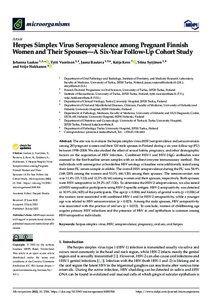Herpes Simplex Virus Seroprevalence among Pregnant Finnish Women and Their Spouses-A Six-Year Follow-Up Cohort Study
Laakso Johanna; Vuorinen Tytti; Rautava Jaana; Kero Katja; Syrjänen Stina; Hukkanen Veijo
Herpes Simplex Virus Seroprevalence among Pregnant Finnish Women and Their Spouses-A Six-Year Follow-Up Cohort Study
Laakso Johanna
Vuorinen Tytti
Rautava Jaana
Kero Katja
Syrjänen Stina
Hukkanen Veijo
MDPI
Julkaisun pysyvä osoite on:
https://urn.fi/URN:NBN:fi-fe2022102463039
https://urn.fi/URN:NBN:fi-fe2022102463039
Tiivistelmä
The aim was to evaluate the herpes simplex virus (HSV) seroprevalence and seroconversion among 285 pregnant women and their 120 male spouses in Finland during a six-year follow-up (FU) between 1998-2008. We also studied the effect of sexual habits, pregnancy, and other demographic factors on the acquisition of HSV infection. Combined HSV-1 and HSV-2-IgG antibodies were assessed in the first baseline serum samples with an indirect enzyme immunoassay method. The individuals with seronegative or borderline HSV serology at baseline were additionally tested using their latest FU serum sample available. The overall HSV seroprevalence during the FU was 58.9% (168/285) among the women and 53.3% (64/120) among their spouses. The seroconversion rate was 11.4% (15/132) and 12.5% (8/64) among women and their spouses, respectively. Both spouses were HSV seropositive in 39.2% (47/120). To determine the HSV-2 seroprevalence, we also tested all HSV-seropositive participants using HSV-2-specific antigen. HSV-2 seropositivity was detected in 10.9% (44/405) of the participants. The age (p = 0.006) and history of genital warts (p = 0.006) of the women were associated with combined HSV-1 and/or HSV-2 seropositivity, while a younger age was related to HSV seroconversion (p = 0.023). Among the male spouses, HSV seropositivity was associated with the practice of oral sex (p = 0.033). To conclude, women of childbearing age acquire primary HSV infections and the presence of HSV in oral epithelium is common among HSV-seropositive individuals.
Kokoelmat
- Rinnakkaistallenteet [27094]
